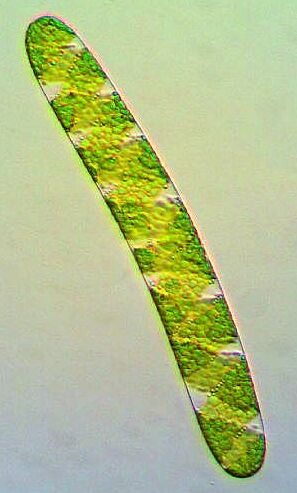Viridiplantae
Viridiplantae, also known as green plants or Chlorobionta, is a kingdom of photosynthetic organisms that includes a wide variety of life forms ranging from simple algae to complex vascular plants. This group is characterized by the presence of chlorophylls a and b, which give them their green color and enable them to perform photosynthesis, converting sunlight into chemical energy. The Viridiplantae are a fundamental part of the Earth's ecosystem, contributing to the oxygen cycle and serving as a base for most terrestrial food webs.
Classification[edit | edit source]
The Viridiplantae are divided into two main clades: the Chlorophyta, which includes most green algae, and the Streptophyta, which includes both algae (such as Charophyta) and all land plants (Embryophyta). This classification is supported by both morphological and molecular evidence, which shows a clear evolutionary line from aquatic to terrestrial life forms.
Chlorophyta[edit | edit source]
The Chlorophyta or green algae are primarily aquatic organisms found in freshwater, marine, and even terrestrial environments. They exhibit a wide range of forms, from single-celled organisms to large, multicellular seaweeds. Chlorophyta are important primary producers in aquatic ecosystems, contributing significantly to the global carbon cycle.
Streptophyta[edit | edit source]
The Streptophyta includes the Charophyta, a group of green algae considered the closest relatives of land plants, and the Embryophyta, or land plants themselves. This clade represents a key step in the evolution of life on Earth, marking the transition from aquatic to terrestrial environments. Land plants have developed adaptations such as a cuticle to prevent water loss, stomata for gas exchange, and vascular tissues for the transport of water and nutrients.
Evolution[edit | edit source]
The evolution of Viridiplantae is a significant event in the history of life on Earth. The oldest known green algae date back to about 1 billion years ago, with the transition to land plants occurring around 500 million years ago during the Cambrian or Ordovician period. This transition allowed for the colonization of land and the development of complex terrestrial ecosystems. The diversification of land plants has been a major driver of the evolution of terrestrial life, providing habitats and food sources for a wide range of organisms.
Ecological Importance[edit | edit source]
Viridiplantae play a crucial role in the Earth's ecosystems. They are primary producers, forming the base of the food web in both aquatic and terrestrial environments. Through photosynthesis, they convert carbon dioxide into oxygen, significantly influencing the Earth's atmosphere and climate. Additionally, green plants are essential for soil formation and stabilization, water cycle regulation, and the provision of resources such as food, fiber, and medicines.
Conservation[edit | edit source]
The conservation of green plants is vital for maintaining biodiversity and ecosystem services. Many species of green plants are threatened by habitat destruction, climate change, pollution, and overexploitation. Conservation efforts focus on protecting habitats, restoring degraded ecosystems, and maintaining genetic diversity within plant populations.
Search WikiMD
Ad.Tired of being Overweight? Try W8MD's physician weight loss program.
Semaglutide (Ozempic / Wegovy and Tirzepatide (Mounjaro / Zepbound) available.
Advertise on WikiMD
|
WikiMD's Wellness Encyclopedia |
| Let Food Be Thy Medicine Medicine Thy Food - Hippocrates |
Translate this page: - East Asian
中文,
日本,
한국어,
South Asian
हिन्दी,
தமிழ்,
తెలుగు,
Urdu,
ಕನ್ನಡ,
Southeast Asian
Indonesian,
Vietnamese,
Thai,
မြန်မာဘာသာ,
বাংলা
European
español,
Deutsch,
français,
Greek,
português do Brasil,
polski,
română,
русский,
Nederlands,
norsk,
svenska,
suomi,
Italian
Middle Eastern & African
عربى,
Turkish,
Persian,
Hebrew,
Afrikaans,
isiZulu,
Kiswahili,
Other
Bulgarian,
Hungarian,
Czech,
Swedish,
മലയാളം,
मराठी,
ਪੰਜਾਬੀ,
ગુજરાતી,
Portuguese,
Ukrainian
Medical Disclaimer: WikiMD is not a substitute for professional medical advice. The information on WikiMD is provided as an information resource only, may be incorrect, outdated or misleading, and is not to be used or relied on for any diagnostic or treatment purposes. Please consult your health care provider before making any healthcare decisions or for guidance about a specific medical condition. WikiMD expressly disclaims responsibility, and shall have no liability, for any damages, loss, injury, or liability whatsoever suffered as a result of your reliance on the information contained in this site. By visiting this site you agree to the foregoing terms and conditions, which may from time to time be changed or supplemented by WikiMD. If you do not agree to the foregoing terms and conditions, you should not enter or use this site. See full disclaimer.
Credits:Most images are courtesy of Wikimedia commons, and templates, categories Wikipedia, licensed under CC BY SA or similar.
Contributors: Prab R. Tumpati, MD






